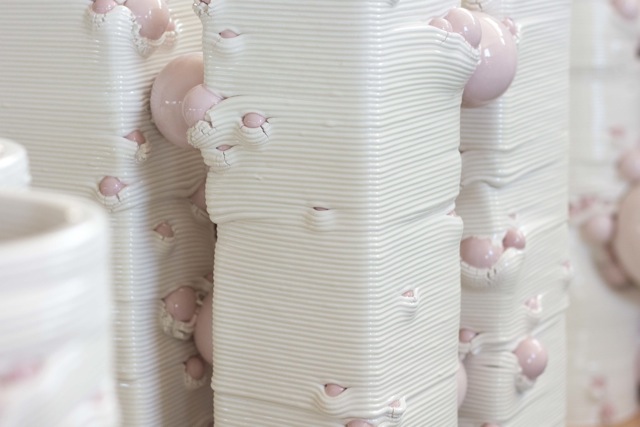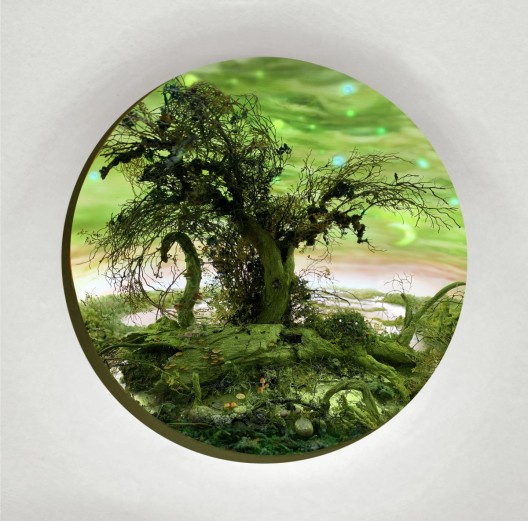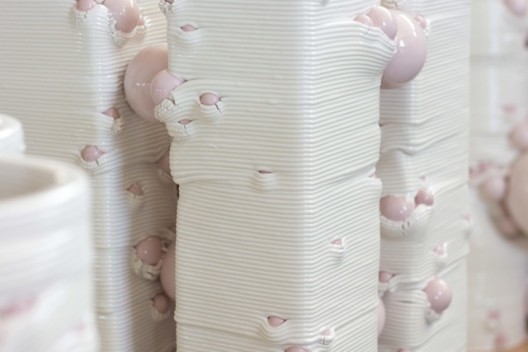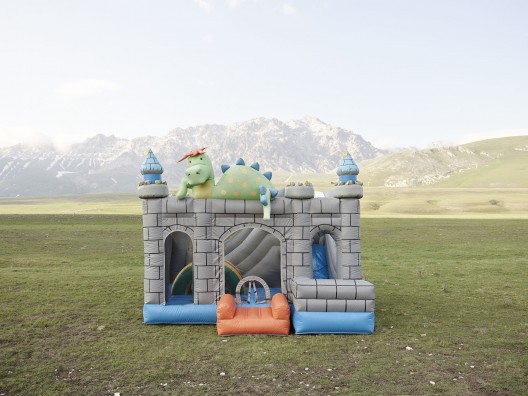On the occasion of the 58th Venice Biennale, THE POOL NYC presents NOTTURNO PIÚ, a group show curated by Giacinto Di Pietrantonio.
There are the ones who see the nocturne in Giotto’s Comet, in San Pietro’s Liberation by Raffaello, in Tintoretto’s work, or even in the Two Men who contemplate the moon by David Caspar Friedrich. Others, in poetry like To the Moon by Giacomo Leopardi, in Whistler’s golden blue color, in the solar stars by Van Gogh, or in futuristic works by Balla and Boccioni. We could go back and forth from dawn to dusk in drawing up the list of artworks whose subject or setting is the night. Certainly, the night was very much courted by the romantics, an era in which the nocturne (nocturne en français) was born. First as a musical work, a form of free, sweet and moderate music that linked up with the serenade. Chopin wrote 21 Nocturnes, Beethoven cheers us with the Moonlight Sonata, even Satie and Debussy did not escape the enterprise. Even literature did not miss the night and the Nocturne as Theodor Amadeus Hoffmann or even Leopardi with the Night Song of a wandering shepherd from Asia. The invitation to the present Notturno Piùexhibit is borrowed from the first cover of the Notturno book, a collection of intimist pizzini written blindfolded because of wounds by the great poet Gabriele D’Annunzio. It is in this evocative frame that we inscribed information and artists’ names for the Notturno Piùexhibition. They are the ones whose work allows returning with the imagination and the memory in the night, in that space time border in which the imagination expands confidentially with the poetics of Mario Airò, Atelier Biagetti, Laura Baldassari, Bertozzi & Casoni, Michel Courtemanche, Mariella Bettineschi, Tomaso Binga, Stefano Cerio, CTRL ZAK, Eteri Chkadua, Jan Fabre, Patrick Jacobs, Ugo La Pietra, Lorenzo Marini, Maria Teresa Meloni, Alessandro Mendini, Aldo Mondino, Francesca Montinaro, Fabio Novembre, Maurizio Orrico, OVO, Paola Pivi, Sarah Revoltella, Jonathan Rider, Andrea Salvatori, Denis Santachiara, Federico Solmi, Giuseppe Stampone, Patrick Tuttofuoco, Vedovamazzei, Alice Visentin.
Ours is not only nocturne, it’s Notturno Più. As night and nocturne are also understood in the form of Blues and Jazz; not only because of the music of the soul, but because of the possibility of jam sessions that offer above all the second. Therefore, it’s an exhibition that is free and mildly moderate, intended as a musical score and set up in a scene writing mode as Carmelo Bene liked to say. A writing – an exhibition in which each artist enters himself and his different work as a composition of a collectively diversified vision with his own unique and complex poetics. The original ones by Mario Airò, the hospitable luxury by Atelier Biagetti, or portraits from the hidden physiognomy of Laura Baldassari‘s lysergic painting, Bertozzi & Casoni’s ceramic realism, the plastic skill of Michel Courtemanche, Mariella Bettineschi’s double feminine gaze, Tomaso Binga’s feminist alphabet, Stefano Cerio’s non-photographic places, the overturned project of CTRL ZAK, the painting testimony of the myths and everyday life of Georgia by Eteri Chkadua, the metamorphic melancholy now blue by Jan Fabre, the meticulous and silent Lilliputian dioramas of Patrick Jacobs, the critical architectural landscape reflections of Ugo La Pietra, the chromatically and futuristically mobile alphabets by Lorenzo Marini, the detailed and ancient portraits by Maria Teresa Meloni, the abstract-futurist signs-decorum by Alessandro Mendini, the illuminating ironic sculptures by Aldo Mondino, the potted plants that hide sculptures of migrant environments by Francesca Montinaro.Fabio Novembre’s tension towards the useless, the abstract-informal paintings by Maurizio Orrico, the precariously hardcover project by OVO, the expansive sign energy of Paola Pivi, the sculptural portraits of the polarized families by Sarah Revoltella, the discrete and almost invisible environmental sculptures by Jonathan Rider, the cosmic vases by Andrea Salvatori, the animated-figured project by Denis Santachiara, the exuberant, noisy and ironic works of Federico Solmi, the responsibly ethical drawings by Giuseppe Stampone, the re-reading of the daily visual codes in the light of the multidisciplinary nature of Patrick Tuttofuoco, the ironic and arrogant landscapes by Vedovamazzei, the playfully shamanic paintings by Alice Visentin.
With this diversity made of 31 artists, the exhibition is an expressive chorus of poetics, techniques, materials that form Notturno Più, where the Più (Plus)is no longer just for the night, but the day and night together, like our life, they can no longer be solitary. This is a group show, an exhibition practice in which you need to be at least in two, the one and the other. Starting a community that counts 31 others, 31 artists with countless works to us, as to them, necessary both day and night to be found in the Notturno Più.
WHERE:
THE POOL NYC at PALAZZO CESARI MARCHESI
Campo Santa Maria del Giglio
Calle Rombiasio 2539 Venezia. Vaporetto Stop: GIGLIO
WHEN:
Opening Reception: Tuesday, May 7th, from 6 to 9 pm
8 May-15 June 2019
Open daily: 11-7
INFO:
+393356251723
+393337891947
thepoolnewyorkcity.com
@thepoolnyc
THE POOL NYC, Palazzo Cesari Marchesi, Calle Rombiasio 2539, Campo Santa Maria del Giglio, Venezia

3 April – 31 May 2019
Opening Reception: Tuesday, April 2nd, from 6 to 9 pm
THE POOL NYC presenta Ikebana Rock’n’Roll, la personale del Maestro della Ceramica Contemporanea, Andrea Salvatori, in conversazione con Giulio Turcato, uno dei principali esponenti dell’Astrattismo Informale Italiano.
THE POOL NYCpresenta Ikebana Rock’n’Roll, la personale del Maestro della Ceramica Contemporanea, Andrea Salvatori, in conversazione con Giulio Turcato, uno dei principali esponenti dell’Astrattismo Informale Italiano.
Salvatori plasma da sempre la ceramica, materiale inorganico, assai duttile allo stato naturale e rigido dopo la cottura. Se nel 2009, agli esordi con la galleria, l’artista proponeva lavori in cui associava inserzioni in ceramica a pezzi trovati in mercatini d’antiquariato, adesso, per la prima mostra nella sede milanese, esordisce con una serie di vasi spumosi, carichi di materia, formosi, pieni di ritmo e poesia.
Per Ikebana Rock’n’RollAndrea Salvatori presenta una serie di vasi bianchi con sfere di diversi toni di rosa, inserite come note musicali,a volte più ritmate, altre più calme. Questi lavori sono pensati come Ikebana, dove natura e spirito si fondono nel tentativo di associare la spiritualità orientale con una leggerezza minimale. L’Ikebana utilizza fiori, rami ed altri elementi naturali per realizzare composizioni di grande bellezza.
“La ricerca dell’equilibrio tra tutti gli elementi passa anche dal contenitore. Ci sono numerose scuole di Ikebana e ognuna opta per un arrangiamento particolare. Alcune usano vasi alti e linee verticali, altre invece contenitori poco profondi”. Infatti i lavori dell’artista faentino hanno dimensioni e forme diverse e il vaso abbraccia così il concetto di scultura con una funzione ben precisa.
Per ladisposizione pratica dei fiori si punta all’asimmetria, tratto caratteristico del lavoro di Salvatori, il quale crea con la ceramica un’armonia speciale,Allegro, Grave, Vivace, Moderato,proprio come nelle composizioni musicali. Alcuni lavori sono più tormentati, più pieni, rock, altri più poetici, più vuoti.
Quello tra Andrea Salvatori e la stampa 3D è un confronto inedito, esuberante e al contempo composto, fatto di fugaci imperfezioni e di pause ragionate, che origina da un’innata conflittualità tra creazione umana e artificio tecnico, tra uomo e macchina. La macchina, in questo caso, è la stampante Delta WASP 40100 Clay, progettata da WASP per essere al fianco dei ceramisti durante tutto il processo artistico, ripensando radicalmente l’ideazione dell’opera grazie alle innovative opportunità offerte dalla fabbricazione digitale.
La stampa 3D è il simbolo di una nuova corrente artistica, frutto di repertori digitali unici e tuttora non sondati dall’arte contemporanea. La collaborazione tra WASP e il Maestro si prefigge di delineare inediti scenari artistici, in cui routine meccaniche e gestualità scultoree coesistono nel dialogo compositivo dell’opera. Salvatori concepisce questo rapporto con un’intuizione estremamente affascinante: manomettere la perfezione della stampa con una miscellanea di inserzioni ceramiche. Il processo di deposizione del materiale e di incastonatura delle sfere è tema centrale nella collezione Ikebana Rock’n’Roll, al punto da convincere Salvatori a denominare le opere “Composizione 40100”, come scaturite da un dialogo musicale dalle tonalità più svariate.
L’artista sconvolge l’algoritmo reiterato pedissequamente dalla macchina con accenti musicali imperfetti, frutto di volta in volta di azioni spontanee e processi ragionati.
Sorge naturale associare le sculture di Salvatori ai dipinti di Turcato: due sperimentatori in fatto di materia.
Giulio Turcato, una presenza costante a La Biennale di Venezia, ha indagato per tutta la vita la materia, usando fluorescenze, pastiglie, sabbie, acrilico e olio.
Nel 1947 Turcato è tra i firmatari di FORMA 1, dove esprime un interesse per una pittura formalista. Nel 1956, dopo un viaggio in Cina, forti sono i riferimenti agli ideogrammi, da cui la nascita dei cosiddetti Reticoli, un trionfo di forme attraverso il colore, che assume una valenza astratta in relazione proprio con se stesso. Col passare degli anni l’artista tende all’assenza della forma.
Agli inizi degli anni ’60 Giulio Turcato viene colpito dalle nevrosi contemporanee e inserisce nei suoi lavori i Tranquillanti, giocando con la materia pittorica e dando vita a composizioni brillanti, astratte, tutte con un piglio musicale. Negli anni delle conquiste spaziali il Maestro inventa opere con sabbie colorate cangianti affermando “la mia ricerca coloristica è orientata verso un nuovo colore…”. È del 1964 la prima Superficie Lunare, realizzata con una striscia di gommapiuma lavorata e combusta. Sarebbe soddisfatto di vedere oggi i toni che hanno assunto i colori da lui medesimo creati.
Nei lavori dell’artista nato a Mantova e mancato a Roma c’è un acceso ritmo informale generato dalla diversità dei materiali usati nelle fasi della sua produzione. THE POOL NYC propone una selezione di opere che spazia dai Reticoli, alle Superfici Lunari, ai Tranquillanti,fino agli Arcipelaghi.
Ikebana e Rock’n’Roll sono in totale contrasto: il primo legato alla spiritualità, il secondo al ritmo di vita terreno e festaiolo. Tutto quanto esiste in natura può essere trasformato in materiale compositivo, purché interpretato nella sua essenza di elemento naturale, riordinato e riespresso e, da inerte, reso vivente. All’origine è dunque la natura, fonte inesauribile di materia prima, modello perfetto che l’uomo può imitare e che l’artista non deve contraffare. Non dimentichiamo che la natura non ripete mai identica una stessa forma, pur moltiplicandola in una quantità potenzialmente infinita.
THE POOL NYC presents Ikebana Rock’n’Roll, the solo show by the Master of Contemporary Ceramics, Andrea Salvatori, in conversation with Giulio Turcato, one of the main exponents of Italian Informal Abstractism.
Salvatori has always molded ceramics, an inorganic material that is very ductile in its natural state and rigid after cooking. Since his debut with the gallery in 2009, where the artist proposed works in which he associated ceramic inserts to pieces found in antique markets, till this first exhibition in the Milanese Gallery, he shows a series of foamy vases, full of matter, curvy, loaded with rhythm and poetry.
For Ikebana Rock’n’RollAndrea Salvatori presents a series of white vases with spheres of different shades of pink, inserted as musical notes, sometimes more rhythmic, sometimes more calm. These works are conceived as Ikebana, where nature and spirit merge in an attempt to associate Oriental spirituality with minimal lightness. Ikebana uses flowers, branches and other natural elements to create compositions of great beauty.
“The search for balance between all the elements also passes through the container. There are numerous schools of Ikebana and each one opts for a particular arrangement. Some use tall vases and vertical lines, others use shallow containers.” In fact the works of the artist from Faenza have different dimensions and shapes and the vase thus embraces the concept of sculpture with a very specific function.
For the practical arrangement of the flowers, the aim is asymmetry, a characteristic trait of Salvatori’s work, which creates a special harmony with ceramics: Allegro, Grave, Vivace, Moderato, just like in musical compositions. Some works are more tormented, fuller, rock, others more poetic, empty.
The one between Andrea Salvatori and 3D printing is a new and exuberant confrontation, made of fleeting imperfections and reasoned pauses, which originates from an innate conflict between human creation and technical artifice, between man and machine. The machine, in this case, is the Delta WASP 40100 Clay printer, designed by WASP to be at the side of the ceramists throughout the artistic process, radically rethinking the conception of the work thanks to the innovative opportunities offered by digital fabrication.
3D printing is the symbol of a new artistic current, the result of unique digital repertoires and still not probed by contemporary art. The collaboration between WASP and the Maestro aims to outline new artistic scenarios, in which mechanical routines and sculptural gestures coexist in the compositional dialogue of the work. Salvatori conceives this relationship with an extremely fascinating intuition: to tamper with the perfection of printing with a miscellany of ceramic insertions. The process of depositing the material and setting the spheres is a central theme in the Ikebana Rock’n’Roll collection, to the point of convincing Salvatori to name the works “Composition 40100”, as if they originated from a musical dialogue of the most varied tones.
The artist alters the repeated algorithm with imperfect musical accents, as a result of spontaneous actions and reasoned processes.The first Lunar Surface dates to 1964 with a strip of processed and burnt foam rubber. He would be pleased to see today that tones have taken on the colors he created himself.
Stefano Cerio, Aquila.
Con Saluti dall’Abruzzo di
Giuseppe Stampone
SABATO 23 MARZO DALLE 17 in galleria



